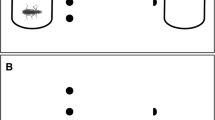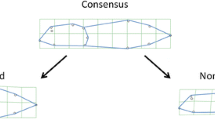Abstract
Life-history theory predicts that predator-induced defences should incur fitness costs. In larval amphibians, the most frequently reported cost is reduced energy intake due to lower foraging rates; however, recent reports suggest that this trade-off may be uncoupled through morphological and physiological adaptations. Metabolism is a measure of energy expenditure and plasticity in respiration may potentially offset other costs of predator-induction. The aim of this study was to measure the indirect effects of dragonfly larvae on the respiration rate of tadpoles of the Arabian toad (Bufo arabicus) over time and at different predator concentrations. We performed two experiments. In the first experiment (time–response), we exposed tadpoles either to the indirect presence of odonate larvae or predator-free conditions and measured respiration rates 3, 5, 8, 11, 13, 15, 19 and 26 days after the start of the experiment. In the second experiment (dose–response), we used three levels of predator chemicals, equivalent to 1 predator per 10, 100 or 1,000 l plus controls. The respiration rate of predator-exposed tadpoles varied initially, but was 56.3% of controls after 26 days. In the dose–response experiment, the respiration rate of all predator-exposed tadpole groups was reduced by between 19.1 and 27.2% after 21 days. The study demonstrates a mechanism by which tadpoles may be able to adjust their physiology to partially offset the costs of lower energy intake due to predator avoidance.


Similar content being viewed by others
References
Alton, L. A., C. R. White, R. S. Wilson & C. E. Franklin, 2012. The energetic cost of exposure to UV radiation for tadpoles is greater when they live with predators. Functional Ecology 26: 94–103.
Balletto, E., M. A. Cherchi & J. Gasperetti, 1985. Amphibians of the Arabian Peninsula. Fauna of Saudi Arabia 7: 318–392.
Barry, M. J., 2011. Effects of copper, zinc and dragonfly kairomone on growth rate and induced morphology of Bufo arabicus tadpoles. Ecotoxicology and Environmental Safety 74: 918–923.
Beckerman, A. P., K. Wieski & D. J. Baird, 2007. Behavioural versus physiological mediation of life history under predation risk. Oecologia 152: 335–343.
Benard, M. F., 2004. Predator-induced phenotypic plasticity in organisms with complex life histories. Annual Review of Ecology & Evolutionary Systems 35: 651–673.
Boonstra, R., D. Hik, G. R. Singleton & A. Tinnikov, 1998. The impact of predator-induced stress on the snowshoe hare cycle. Ecological Monographs 68: 371–394.
Brown, G. E., A. C. Rive, M. C. O. Ferrari & D. P. Chivers, 2006. The dynamic nature of antipredator behavior: prey fish integrate threat-sensitive antipredator responses within background levels of predation risk. Behavioral Ecology and Sociobiology 61: 9–16.
Dries, R. R., L. Eschweiler & H. Theede, 1979. An improved equipment for continuous measurement of respiration of marine invertebrates. Kieler Meeresforsch 4: 310–316.
Ferrari, M. C. O., F. Messier & D. P. Chivers, 2007. Degradation of chemical alarm cues under natural conditions: risk assessment by larval woodfrogs. Chemoecology 17: 263–266.
Ferrari, M. C. O., B. D. Wisenden & D. P. Chivers, 2010. Chemical ecology of predator-prey interactions in aquatic ecosystems: a review and prospectus. Canadian Journal of Zoology 88: 698–724.
Fraker, M. E., 2008. The dynamics of predation risk assessment: responses of anuran larvae to chemical cues of predators. Journal of Animal Ecology 77: 638–645.
Fuhrman, F. A., G. J. Fuhrman, D. A. Farr & J. H. Fail, 1961. Relationship between tissue respiration and total metabolic rate in hypo- and normothermic rats. American Journal of Physiology—Legacy Content 201: 231–234.
Gervasi, S. S. & J. Foufopoulos, 2008. Costs of plasticity: responses to desiccation decrease post-metamorphic immune function in a pond-breeding amphibian. Functional Ecology 22: 100–108.
Gosner, K. L., 1960. A simplified table for staging anuran embryos and larvae with notes on identification. Herpetologica 16: 183–190.
Hayes, J. P., J. R. Speakman & P. A. Racey, 1992. Sampling bias in respirometry. Physiological Zoology 65: 604–619.
Helfman, G. S., 1989. Threat-sensitive predator avoidance in damselfish–trumpetfish interactions. Behavioral Ecology and Sociobiology 24: 47–58.
Hernandez-León, S. & T. Ikeda, 2005. Zoolplankton respiration. In del Giorgio, P. A. & P. J. le. B. Williams (eds), Respiration in Aquatic Ecosystems. Oxford University Press, Oxford: 57–82.
Holopainen, I. J., J. Aho, M. Vornanen & H. Huuskonen, 2005. Phenotypic plasticity and predator effects on morphology and physiology of crucian carp in nature and in the laboratory. Journal of Fish Biology 50: 781–798.
Jara, F. G., 2008. Tadpole–odonate larvae interactions: influence of body size and diel rhythm. Aquatic Ecology 42: 503–509.
Kats, L. B. & L. M. Dill, 1998. The scent of death: chemosensory assessment of predation risk by animals. Ecoscience 5: 361–394.
Kehr, A. I. & V. I. Gómez, 2009. Intestinal, body and tail plasticity in Rhinella schneideri (Bufonidae) tadpoles induced by a predator insect (Belostoma elegans). Advanced Studies in Biology 1: 85–94.
Kiesecker, J. M., D. P. Chivers & A. R. Blaustein, 1996. The use of chemical cues in predator recognition by western toad tadpoles. Animal Behaviour 52: 1237–1245.
Kishida, O. & K. Nishimura, 2005. Multiple inducible defenses against multiple predators in the anuran tadpole, Rana pirica. Evolutionary Ecology Research 7: 619–631.
Lampert, W., 1984. The measurement of respiration. In Downing, J. A. & F. H. Rigler (eds), A manual on methods for the assessment of secondary productivity in fresh water. IPB Handbook 17, 2nd edn. Blackwell Scientific Publications: 413–468.
Laurila, A., 2000. Behavioural responses to predator chemical cues and local variation in antipredator performance in Rana temporaria tadpoles. Oikos 88: 159–168.
Laurila, A., J. Kujasalo & E. Ranta, 1997. Different antipredator behaviour in two anuran tadpoles: effects of predator diet. Behavioral Ecology and Sociobiology 40: 329–336.
Lawton, J. H. & S. McNeil, 1979. Between the devil and the deep blue sea: on the problem of being a herbivore. Symposium of the British Ecological Society 20: 223–244.
Lively, C. M., 1986. Predator-induced shell dimorphism in the acorn barnacle Chthamalus anisopoma. Evolution 40: 232–242.
McCarthy, I. D., 2000. Temporal repeatability of relative standard metabolic rate in juvenile Atlantic salmon and its relation to life history variation. Journal of Fish Biology 57: 224–238.
McCollum, S. A. & J. D. Leimberger, 1997. Predator-induced morphological changes in an amphibian: predation by dragonflies affects tadpole shape and color. Oecologia 109: 615–621.
McIntyre, P. B. & S. A. McCollum, 2000. Responses of bullfrog tadpoles to hypoxia and predators. Oecologia 125: 301–308.
McPeek, M. A., 2004. The growth/predation risk trade-off: so what is the mechanism? The American Naturalist 163: 88–111.
McPeek, M. A., M. Grace & J. M. L. Richardson, 2001. Physiological and behavioral responses to predators shape the growth/predation risk trade-off in damselflies. Ecology 82: 1535–1545.
Peacor, S. D., 2002. Positive effect of predators on prey growth rate through induced modifications of prey behaviour. Ecology Letters 5: 77–85.
Puttlitz, M. H., D. P. Chivers, J. M. Kiesecker & A. R. Blaustein, 1999. Threat-sensitive predator avoidance by larval pacific treefrogs (Amphibia, Hylidae). Ethology 105: 449–456.
Quinn, G. P. & M. J. Keough, 2002. Experimental design and data analysis for biologists. Cambridge University Press, Cambridge.
Relyea, R. A., 2001. Morphological and behavioral plasticity of larval anurans in response to different predators. Ecology 82: 523–540.
Relyea, R. A., 2002a. Costs of phenotypic plasticity. American Naturalist 159: 272–282.
Relyea, R. A., 2002b. The many faces of predation: how induction, selection, and thinning combine to alter prey phenotypes. Ecology 83: 1953–1964.
Relyea, R. A. & J. R. Auld, 2004. Having the guts to compete: how intestinal plasticity explains costs of inducible defences. Ecology Letters 7: 869–875.
Richardson, J. M. L., 2001. A comparative study of activity levels in larval anurans and response to the presence of different predators. Behavioral Ecology 12: 51–58.
Rowe, C. L., O. M. Kinney, R. D. Nagle & J. D. Congdon, 1998. Elevated maintenance costs in an Anuran (Rana catesbeiana) exposed to a mixture of trace elements during the embryonic and early larval periods. Physiological Zoology 7: 27–35.
Schoeppner, N. M. & R. A. Relyea, 2008. Detecting small environmental differences: risk–response curves for predator-induced behavior and morphology. Oecologia 154: 743–754.
Sih, A., 1992. Prey uncertainty and the balancing of antipredator and feeding needs. The American Naturalist 139: 1052–1069.
Skelly, D. K., 1992. Field evidence for a cost of behavioral antipredator response in a larval amphibian. Ecology 73: 704–708.
Slos, S. & R. Stoks, 2008. Predation risk induces stress proteins and reduces antioxidant defense. Functional Ecology 22: 637–642.
Smith, M. E., J. M. Lazorchak, L. E. Herrin, S. Brewer-Swartz & W. T. Thoeny, 1997. A reformulated, reconstituted water for testing the freshwater amphipod, Hyalella azteca. Environmental Toxicology and Chemistry 16: 1229–1233.
Steiner, U. K., 2007. Linking antipredator behaviour, ingestion, gut evacuation and costs of predator-induced responses in tadpoles. Animal Behaviour 74: 1473–1479.
Steiner, U. K. & J. Van Buskirk, 2009. Predator-induced changes in metabolism cannot explain the growth/predation risk tradeoff. PLoS One 4: e6160.
Stibor, H. & J. Machacek, 1998. The influence of fish-exuded chemical signals on the carbon budget of Daphnia. Limnology and Oceanography 43: 997–1000.
Stoks, R., 2001. Food stress and predator-induced stress shape developmental performance in a damselfly. Oecologia 127: 222–229.
Stoks, R., M. D. Block, F. Van De Meutter & F. Johansson, 2005. Predation cost of rapid growth: behavioural coupling and physiological decoupling. Journal of Animal Ecology 74: 708–715.
Takahara, T., Y. Kohmatsu, A. Maruyama & R. Yamaoka, 2008. Benefit of suites of defensive behavior induced by predator chemical cues on anuran tadpoles, Hyla japonica. Behavioral Ecology and Sociobiology 63: 235–240.
Tollrian, R., 1993. Neckteeth formation in Daphnia pulex as an example of continuous phenotypic plasticity: morphological effects of Chaoborus kairomone concentration and their quantification. Journal of Plankton Research 15: 1309–1318.
Tollrian, R. & C. D. Harvell, 1999. The ecology and evolution of inducible defenses. Princeton University Press, Princeton.
Van Buskirk, J. & M. Arioli, 2002. Dosage response of an induced defense: how sensitive are tadpoles to predation risk? Ecology 83: 1580–1585.
Van Buskirk, J., C. Müller, A. Portmann & M. Surbeck, 2002. A test of the risk allocation hypothesis: tadpole responses to temporal change in predation risk. Behavioral Ecology 13: 526.
Victor, R., 2004. Limnology in the Sultanate of Oman. In Gopal, B. & R. M. Wetzel (eds), Limnology in developing countries. International Scientific Publications, New delhi: 219–244.
Voutilainen, A., E. Seppänen & H. Huuskonen, 2011. A methodological approach to measuring the oxygen consumption profile of six freshwater fish species: implications for determination of the standard metabolic rate. Marine and Freshwater Behaviour and Physiology 44: 239–250.
Wisenden, B. D., 2000. Olfactory assessment of predation risk in the aquatic environment. Philosophical Transactions of the Royal Society B 355: 1205–1208.
Wisenden, B. D., M. L. Rugg, N. L. Korpi & L. C. Fuselier, 2009. Lab and field estimates of active time of chemical alarm cues of a cyprinid fish and an amphipod crustacean. Behaviour 146: 1423–1442.
Acknowledgments
This study was supported by the Sultan Qaboos University Internal Grant. All experiments were conducted under guidelines permitted by the Sultan Qaboos University Animal Ethics Committee regulations. The authors thank Dr Derek Roberts and several anonymous reviewers for their suggestions that helped in greatly improving this manuscript.
Author information
Authors and Affiliations
Corresponding author
Additional information
Handling editor: Lee B. Kats
Rights and permissions
About this article
Cite this article
Barry, M.J., Syal, S. Metabolic responses of tadpoles to chemical predation cues. Hydrobiologia 700, 267–276 (2013). https://doi.org/10.1007/s10750-012-1236-4
Received:
Revised:
Accepted:
Published:
Issue Date:
DOI: https://doi.org/10.1007/s10750-012-1236-4




